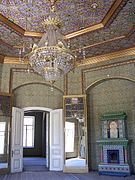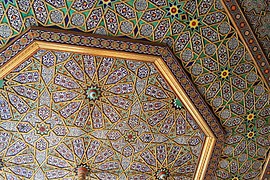Nurulla-Bei Palace
Coordinates: 41 ° 22 ′ 58.5 ″ N , 60 ° 21 ′ 25.4 ″ E
The Nurulla-Bei-Palace ( Uzbek Nurullaboy saroyi ) is a palace in the Uzbek city of Khiva (Khiva) . It was built at the beginning of the 20th century by order of the then Khan of Khiva, Said Muhammad Rahim II . When completed in 1912, it served as a residence for Khan Esfendijar , the last ruler of the Khiva Khanate .
Building history
The planning and large parts of the construction period of the palace fell during the tenure of Said Muhammad Rahim II, who had been Khan of Khiva since 1863. During his tenure, the khanate was conquered by the Russian Empire and has been under its protectorate since 1873 . In addition, brisk construction activity, especially in Ichan Qalʼа , the historic city center of Chiwa, marked the reign of Khan Rahim II.

The plans for a new palace complex for the Khan's family emerged in the 1890s. Due to the lack of space in the city center Ichan Qalʼа, the palace complex was built outside of the historical city center in the northwest of Chiwa on the area of a former park. Before construction began, the park was owned by the wealthy merchant Nurulla Bei, who only consented to the sale of his property on the condition that the palace complex was to bear his name in the future. Due to this incident, the palace bears the name of the merchant to this day.
The construction of the Nurulla-Bei-Palace began in 1904 and was continued under the new Khan Esfendijar, who took office after the death of his father Rahim II in 1910. In addition to craftsmen and artists from Khiva, specialists from Russia and Germany were also involved in the construction, and they influenced the design of the facility. Some of the building materials were also imported, including the tiles and ceramic work used, most of which were made in Saint Petersburg .
The palace was completed in 1912, two years after the death of the original builder. The building was then used as a residence by the Khan and his family until the history of the Khiva Khanate ended in 1920 with the death of Esfendijar and the incorporation of the Khanate into the newly founded People's Republic of Khorezmia .
In the recent past, the main focus was on maintaining the facility, among other things, the reconstruction of the utility rooms and the harem was completed in 2017 . Due to its location outside the UNESCO World Heritage Site Ichan Qalʼа, the Nurulla Bei Palace is not one of the most famous sights of the city, but is still part of numerous tourist visits in Khiva.
description
The entire palace complex extends over an area of 198 by 143 meters and includes a small park and several buildings. The complex is enclosed by a brick wall, which is crowned by small towers, also made of bricks.
The more than 100 rooms in the complex include a harem, a small mosque , a stable and numerous rooms for servants. In the splendidly furnished main building of the complex there are three differently designed living rooms for the Khan's family, a reception room, a waiting room, a throne room and a banquet room. These rooms were intended for the reception of guests and were extremely richly decorated and decorated. The European influence was particularly pronounced in the interior of the building. The design of the floor, windows and ceiling was largely carried out by German craftsmen and artists, while the particularly magnificent throne room in the Art Nouveau style is characterized in particular by Russian style elements and pieces of furniture as well as a magnificent chandelier made in Russia.
Overall, the architecture of the building is characterized by a mix of traditional oriental architecture and European style elements.
gallery
Web links
Individual evidence
- ↑ Palace of Nurullah-bai, Khiva. In: orexca.com. Accessed March 19, 2021 .
- ↑ a b Irina Thöns, Bodo Thöns: Uzbekistan: Along the Silk Road to Tashkent, Samarkand, Bukhara and Chiwa . 13th edition. Trescher Verlag , Berlin 2020, ISBN 978-3-89794-453-4 , pp. 394 f .
- ^ Klaus Pander: Art Travel Guide Central Asia . 9th edition. DuMont Buchverlag , Cologne 2013, ISBN 978-3-7701-3680-3 , pp. 187 f .
- ↑ The Palace of Nurullah - Bai. In: centralasia-adventures.com. Accessed March 19, 2021 .






